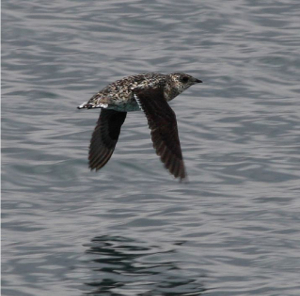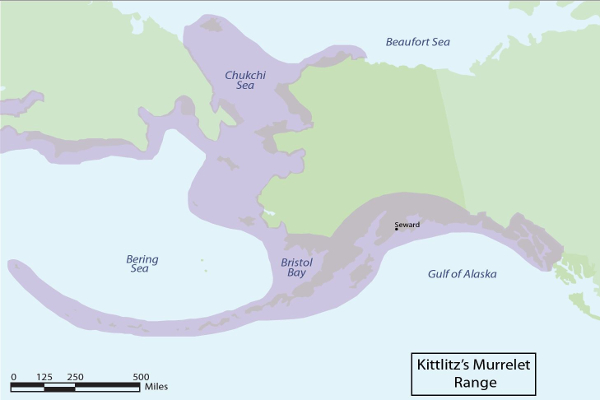Natural History

The Kittlitz’s murrelet is a small diving bird that breeds and winters along coastal Alaska and northeastern Russia. They are associated with glacially influenced marine habitats and prefer to feed near stable or advancing tidewater glaciers where there is a diverse and abundant amount of forage fish. Unlike the majority of seabirds, Kittlitz’s murrelets are solitary nesters, laying a single egg in a small scrape in unvegetated scree slopes or cliff faces.
Because they nest in remote locations, it is difficult to study their breeding behavior. Generally, population estimates of breeding Kittlitz’s murrelets are determined by counting birds along the coastline from June to August. Total population can be difficult to determine from these numbers as adult murrelets do not breed every year and the number of murrelets present near breeding areas fluctuates throughout the summer. Surveys can also be challenging since it is difficult to distinguish Kittlitz’s murrelets from marbled murrelets, a close cousin found in large numbers along the Alaskan coast.
In Kenai Fjords National Park, Kittlitz’s murrelets are most commonly seen near tidewater glaciers.
Kittlitz’s Murrelet Population
Surveys in Kenai Fjords

In 1976, E.P. Bailey conducted the first survey that documented Kittlitz’s murrelets in what would become Kenai Fjords National Park. His study was part of a larger survey of all marine birds along the southern Kenai Peninsula coast. Later surveys were conducted in 1986 and in 1989 after the Exxon Valdez Oil Spill to determine how marine bird populations had changed since the 1976 Bailey survey. In 2002, as evidence began to emerge that Kittlitz’s murrelet populations in parts of Alaska were experiencing drastic declines, Van Pelt and Piatt conducted a survey in Kenai Fjords focused exclusively on murrelets. Calculations based on these surveys indicate that the Kittlitz’s murrelet population increased 55% between 1986 and 1989 and decreased 90% between 1989 and 2002.
This apparent decline prompted a three year study from 2006 to 2008 by Arimitsu and colleagues to detail the distribution and abundance of Kittlitz’s murrelets in Kenai Fjords. They improved survey design and established standardized transects, which were surveyed multiple times each year of the study. They found that the number of Kittlitz’s murrelets in the fjords generally increased between June and July but rapidly dispersed in August. There was also significant year to year variation in the breeding population with 925 Kittlitz’s murrelets detected in 2006, 423 in 2007, and 801 in 2008. The Arimitsu study estimated the Kittlitz’s murrelet population in Kenai Fjords to be at least 716 individuals.
The highest concentrations of Kittlitz’s murrelets were found near the tidewater glaciers in Northwestern Lagoon, near Aialik Glacier in Aialik Bay and, to a lesser extent, next to Holgate Glacier in Aialik Bay and McCarty Glacier in McCarty Fjord. Managers at Kenai Fjords should be able to detect population changes accurately in the future by following the protocols and using transects established during the 2006-2008 study.
REFERENCES
Arimitsu, M.L., J.F. Piatt, M.D. Romano, E.N. Madison, and J.S. Conaway. 2010. Kittlitz’s and Marbled murrelets in Kenai Fjords National Park, south-central Alaska: At-sea istribution, abundance, and foraging habitat, 2006-08: U.S. Geological Survey Open-File Report 2010-1181, 68p.
Arimitsu, M.L., J.F. Piatt, M.D. Romano, and T.I. Van Pelt. 2011. Status and distribution of the Kittlitz’s murrelet Brachyramphus brevirostris in Kenai Fjords, Alaska. Marine Ornithology 39:13-22.
Bailey, E.P. 1976. Breeding seabird distribution and abundance
along the south side of the kenai Penninsula, Alaska. Unpublished report, U.S. Fish and Wildlife Service, Homer, Alaska.
Bailey, E.P., and B. Rice. 1989. Assesment of injury to seabird and marine mammal populations along the southeast coast of the Kenai Peninsula, Alaska, from the Exxon Valdez oil spill during summer of 1989. Unpublished report, U.S. Fish and Wildlife Survey, Homer, Alaska.
Nishimoto, M. and B. Rice. 1987. A re-survey of seabirds and
marine mammals along the south coast of the Kenai Peninsula, Alaska, during the summer of 1986. Unpublished report, U.S. Fish and Wildlife Survey, Homer, Alaska.
Van Pelt, T.I., and J.F. Piatt. 2003. Population status of Kittlitz’s and Marbled Murrelets and surveys for other marine bird and mammal species in the Kenai Fjords area, Alaska.Science Support Program/Species at Risk Annual Report for U.S. Fish and Wildlife Service, U.S. Geological Survey Alaska Science Center, Anchorage, Alaska, 65pp.
Program Contact:
Park Ecologist
Kenai Fjords National Park
(907) 422-0500
P.O. Box 1727 Seward, AK 99664
Last updated: February 7, 2017
